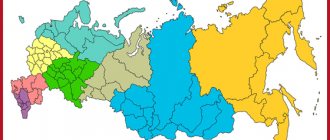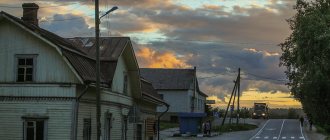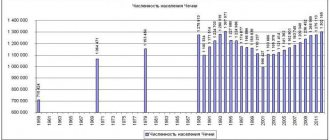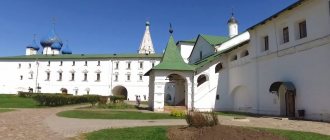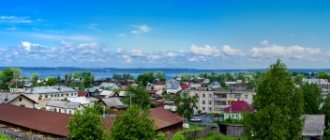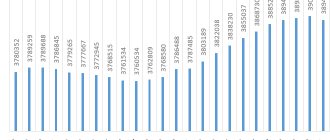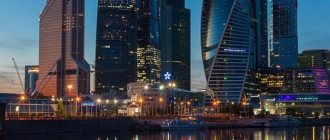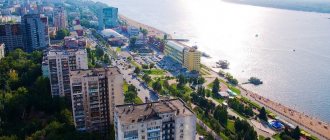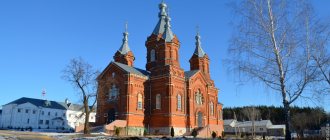What holiday is it today?
January 22, 2022, Saturday
Today are holidays, events: Day of Unification of Ukraine Tomorrow: Premiere of the opera “Eugene Onegin” at the Bolshoi Theater
Today is the Orthodox holiday: Martyr Polyeuctus. St. Philip, Metropolitan of Moscow and All Russia, wonderworker... Tomorrow: St. Gregory, Bishop of Nyssa. Venerable Markian the presbyter. Venerable Dometian, Bishop of Melitino. St. Paul of Komel, wonderworker, student of St. Sergius of Radonezh. Saint Theophan, the Recluse of Vyshensky...
Today is a national holiday: St. Philip's Day... Tomorrow: Gregory - Summer Guide...
Seasons
Seasons, four periods of the year (spring, summer, autumn and winter) characterized by certain average temperatures. The period during which the Sun passes through one of these sectors is called the season. Spring in the Northern Hemisphere and autumn in the Southern Hemisphere begin when the Sun passes through the initial circle of declination and its right ascension is 0° (vernal equinox). Summer in the Northern Hemisphere and winter in the Southern Hemisphere occur when the sun's right ascension is 90° (summer solstice). Autumn in the Northern Hemisphere and spring in the Southern Hemisphere begin when the sun's right ascension is 180° (autumnal equinox). The beginning of winter in the Northern Hemisphere and summer in the Southern Hemisphere is considered to be the winter solstice, when the direct ascension of the Sun is 270°... Next: Seasons. Russian folk calendar. Monthly words...
History of Samara
Samara was first mentioned in documents in 1357, when Moscow Metropolitan St. Alexy visited this area while traveling to the Golden Horde. In the documents one can find another mention of the settlement-marina Samar around the same period - in 1367. 200 years later, Fyodor Ioannovich, the Tsar, ordered the founding of a fortress south of the pier. The purpose of this construction was to protect the banks of the Volga and the southern borders of Rus'. Historians consider the date 1586 to be the year of the founding of Samara. There are several translations of the name: some claim that Samara means “steppe river” from Turkic. Others are of the opinion that from Greek samar means merchant, ra means Volga.
In the period 1935-1991. the city was named after Valerian Kuibyshev. When the war was going on, evacuated factories were located in Samara. At that time, aircraft, weapons, and ammunition were produced here. After some time, Samara became known as the 163rd region.
Folk calendar about every day
Every day one season always replaces another and this determines a person’s way of life. In connection with this, a folk calendar was formed in which there were practically no nameless, unmarked days. Every day was special, had its own purpose. All this was determined by climate conditions and astrological phenomena.
A calendar is a system for counting periods of time. The first calendars arose a long time ago, in ancient times, because there was a need to measure time. The word calendar comes from the Latin words caleo - to proclaim and calendarium - debt book. This is due to the fact that in Ancient Rome the beginning of each month was especially proclaimed, and because it was customary to pay debts on the first day of the month. Different peoples counted time differently. Some calendars are based on the changing phases of the moon - lunar calendars; in others - the change of seasons - sunny; in others, the length of the year was coordinated with the change of seasons, and the counting of months was associated with the phases of the Moon. Such calendars are called lunisolar.
In Rus', the calendar was called a monthly calendar. Every day, the month book covered the entire year of peasant life, “describing” day by day, month after month, where each day had its own holidays or weekdays, customs and superstitions, traditions and rituals, natural signs and phenomena. The cyclical nature of the calendar is reminiscent of human life, where spring is youth, summer is heyday, autumn is the time of harvesting fruits (it’s good if there are some, otherwise you can live your life without collecting fruits), winter is the time of wisdom and peace. This cyclicality and rhythm determined the way of life of the farmer. The folk calendar was an agricultural calendar, which was reflected in the names of the months, folk signs, rituals and customs. Even the determination of the timing and duration of the seasons is associated with real climatic conditions. Hence the discrepancy between the names of the months in different areas... Next: Folk calendar...
Fishing calendar for every day
The fishing calendar should not be taken as an absolutely indisputable truth. Fish biting is greatly influenced by a whole range of natural factors, as well as the influence on the nature of man himself. You must not forget that the fish’s bite depends and is determined not only by the calendar dates and biological cycles of their life, reflected in the calendar, but also, no less, by the state of their habitat; the bite also depends on weather conditions: air and water temperatures, cloudiness, wind direction and strength, etc... Next: Fishing calendar...
Administrative division
Like all cities, Samara is administratively divided into several districts:
- Leninist;
- Kirovsky;
- Kuibyshevsky;
- October;
- Soviet;
- Samara;
- Railway;
- Krasnoglinsky;
- Industrial.
It so happened that initially the city was built closer to the Volga, so it was here that historical buildings, business centers, cultural and administrative premises accumulated. The areas adjacent to the embankment are called central. Oktyabrsky, Leninsky, Zheleznodorozhny, Samara districts are located here.
Orthodox calendar about every day
Orthodox calendar: Orthodox, Church and Christian holidays.
The church year is an alternation of weekdays and holidays. On weekdays, a person is called to work “by the sweat of his brow to earn his bread.” Holidays are given in order to feel liberation, to rise above the bustle and routine of the world, to feel involved in the highest of worlds, “where there are no illnesses, sorrows and sighs, but endless life.” Since ancient times, holiday cycles have been associated with the seasons. The pagans associated them with the worship of the forces of nature, the cult of which in the Old Testament was replaced by gratitude to the Creator for the universe. And although the connection between holidays and the seasons has not completely lost its power, since God is present in everything, in the plant and animal world, in human works, it nevertheless faded into the background, giving way to a spiritual foundation built on the Sacred Scriptures. The history of Orthodox holidays dates back to the times of the Old Testament. Each of the Orthodox holidays is dedicated to the remembrance of the most important events in the life of Jesus Christ and the Mother of God, as well as the memory of saints... Next: Orthodox calendar...
Russian folk calendar for every day
The word “sign” comes from the word “notice”, i.e. observe. As a result of observing what happens around a person every day, he accumulates life experience. This knowledge was passed down from generation to generation, carefully preserved and people trusted it as a sacred book. Many signs have come to us from the depths of centuries without losing their knowledge. Each of us is free to choose: to dismiss all this as an absurd superstition or to take a closer look at the signs and take the centuries-old experience of generations more seriously. Most of us, when taking exams, ask them to scold them, boasting about some kind of good fortune or luck, spit so as not to jinx them or knock on wood, take a detour if a black cat crossed the road, are afraid of the number 13 and much more. And who among us does not have lucky things, numbers? Who has never resorted to the help of fate at least once in their life, who has not believed in secrets? It’s as if everything connected with signs is hidden somewhere deep in our subconscious. Often we remember them mechanically, unconsciously, or just as a joke. But, undoubtedly, the signs contain a lot of accurate knowledge and practical wisdom of our ancestors. They cover all the characteristic, often difficult to perceive, natural phenomena. Signs have preserved a lot of what was in old folk holidays and customs; they help predict the weather, grow crops... Next: Folk signs...
Samara
Story
The Samara fortress on the spit of the Volga and Samara rivers was built in 1586 to ensure the safety of the Volga river route. The construction of the fortress was led by the governor, Prince Grigory Zasekin. In 1600, a customs house and a pier on the Volga were established in Samara. Merchants from Russia and Central Asian countries traded at the Samara bazaar. By order of Tsar Alexei Mikhailovich, additional fortifications were built in Samara in 1645. In August 1670, an uprising of the poor arose in the city, and the gates of the fortress were opened to Stepan Razin. But after the defeat at Simbirsk, the Razins were no longer allowed into the fortress. On December 25, 1773, Samara went over to the side of Emelyan Pugachev. The city was liberated from the Pugachevites by the field team of Lieutenant Colonel P. Grinev, who became the prototype of one of the characters in AC Pushkin’s story “The Captain’s Daughter.”
In 1688, the Samara fortress was renamed a city. In 1730, the first coat of arms of the city was approved. In 1780, it was confirmed by a decree of Catherine II in its previous form - in the form of a shield, which depicts “a white wild goat standing on the grass in a blue field.” In 1851 Samara became the center of the province. Before the revolution, it was an important center of grain trade on the Volga. In search of characters for their paintings, I. Repin and V. Surikov came to the banks of the Volga in the Samara region.
On January 27, 1935, Samara was renamed Kuibyshev. During the Great Patriotic War, the city acquired the status of the second capital of the USSR. The People's Commissariat for Foreign Affairs, the diplomatic corps, the apparatus of the Central Committee of the Party and Komsomol, and the Council of People's Commissars of the USSR moved here. During the war, troupes of a number of Moscow and Leningrad theaters were in the city. Here Dmitri Shostakovich's famous Seventh Symphony was completed and performed for the first time. During these years, writers A. Tolstoy, V. Vasilevskaya, I. Erenburg, V. Ivanov, V. Kataev lived in Kuibyshev.
In the autumn and winter of 1941-1942, equipment from a number of enterprises in Ukraine, Belarus, Moscow, and Leningrad was evacuated to Samara. The factories built in Samara during the war and the specialists from these enterprises predetermined the powerful development of the region's industry in the post-war period. A large concentration of military-industrial enterprises “closed” the city to foreigners.
After the war, Kuibyshev continued to develop as a major industrial center. Kuibyshev was the administrative center of the Kuibyshev region.
After the collapse of the USSR, the city was returned to its historical name - Samara, and the Kuibyshev region was renamed back to Samara.
Today Samara is a very beautiful and modern city with a very large number of museums and historical attractions, which allows it to compete on equal terms with St. Petersburg and Nizhny Novgorod.
Attractions
Samara, one of the most beautiful cities in the Volga region, has retained the charm of an old merchant city. The leading role in the organization of life, everyday life and culture of the city belonged to the merchants. The architecture of the city lacks buildings in the Empire style, but there are eclecticism, neo-Russian style and modernism. Ensembles in the style of constructivism are interesting.
Among the buildings of the second half of the 19th - early 20th centuries, erected in eclectic and stylized styles: Drama Theater (1887-1888, “Russian” style - under the Moscow Baroque; architect M. N. Chichagov); the mansion of engineer I. A. Klodt, similar to a fairy-tale gnome’s house (1880s, neo-romanticism, architect A. A. Shcherbachev); Trade Exchange (1890s, neoclassical, architect A. A. Shcherbachev); Peasant Land Bank (Technical University; 1912, in the style of Scandinavian architecture, architect A. I. Gauguin); Volga-Kama Bank (1913-1915, neoclassical, architect V.I. Yakunin); former Yakimov mill (turn of the 19th-20th century, “Russian” style); Shikhobalov mansions (1890s, neo-baroque, architect A. A. Shcherbachev); Naumova (1903-1905, neo-Renaissance, architect A. A. Shcherbachev); apartment house Subbotina-Martinson (1914, neo-Gothic; architect Kvyatkovsky); Lutheran church (1860-1870s, neo-Gothic); Church of the Heart of Jesus (1906, neo-Gothic, architect F. O. Bogdanovich).
A real school was built in the Art Nouveau style (1840, reconstructed in 1906-1909; architect P.V. Shamansky); theater-circus "Olympus" (1907, architect Shamansky); the Grand Hotel (now the Zhiguli Hotel, 1908-1909, architect M. Kvyatovsky), mansions of von Vacano (northern modern; architect D. N. Werner), Kurlina (early 1900s, architect A U. Zelenko). In the area of Central Park, almost at the very edge of the steep bank, there is the building of the former summer house of the artist Konstantin Golovkin (1908-1909; architect V. Tepfer), on the site in front of which there are two stone elephants facing each other. The facades of this Art Nouveau building are completely different from each other and stand out clearly against the background of the surrounding greenery.
One of the oldest religious buildings is Samara’s Ascension Cathedral (1830). The Intercession Cathedral (1859-1861) was built with donations from wealthy Samara families, among whom were the Shikhobalov merchants, whose family crypt was built in the church fence. The Peter and Paul Church (1861) was built in the classicist tradition; the icons for the temple iconostasis were painted by master Grigory Zhuravlev, a cripple from birth, who painted icons holding a brush in his teeth. The Samara Synagogue (1903-1908; architect Z. Kleinerman) was built in the Moorish style, and at the time of construction it was one of the largest in Europe. In 1999, the Cathedral Mosque opened in Samara, at that time the largest Muslim temple in Russia.
Samara's museums are of great interest: local history, history of Samara, aviation and astronautics, military history, art, literature, archeology of the Volga region, Stalin's bunker and the house-museum of V. I. Lenin. In the exhibition of the Samara Art Museum you can see works by Repin, Surikov, Kramskoy, Polenov, Yaroshenko, Makovsky, K. Golovkin, which came from the collections of wealthy Samara merchants. Here is the richest collection of works of the Russian avant-garde of the early 20th century, first-class works by Malevich, Konchalovsky, Lentulov, Burliuk are stored.
The exhibition of the Museum-Workshop of Folk Costumes of the Samara Province presents national costumes and attributes of the peoples of the Volga region (Russian, Mordovian, Chuvash, Tatar), products of masters of decorative and applied arts. In the vicinity of Samara in the Sokoli Mountains there is the cave of the Greve brothers, where in the labyrinths of the karst system scientists discovered traces of a Bronze Age site. The bones of a cave bear and a woolly rhinoceros were also found here. The sanatoriums “Volga”, “Krasnaya Glinka”, “Ivushka” provide treatment for diseases of the cardiovascular system, central and peripheral nervous system, musculoskeletal system, gynecological, and skin diseases.
Holiday calendar, dates and events of the year
All state and professional holidays in Russia, including significant World and International holidays, and other equally interesting holidays and events about every day.
The holiday has always kept pace with the history of mankind. Social time can be divided into three types: everyday life (weekdays), weekends and holidays. Everyday life is a series of practices repeated day after day and every day (work). Weekends are regular breaks from the rush of everyday life. It is believed that on weekends a person should restore his strength after working days. Day off, non-working day. A holiday is a day of celebration established in honor or in memory of someone or something. A day or series of days celebrated by the church in memory of a religious event or saint... Next: Calendar...
Prayer book, Orthodox prayers for every day
Prayer is the most powerful means for healing all illnesses - both physical and mental. Prayers can be laudatory or grateful, petitionary and repentant. If we have offended God, sinned, we must ask Him for forgiveness, that is, repent. Such prayers are called repentant prayers. If everything is fine with us, if we and our loved ones are healthy and prosperous, if we have a place to live, something to wear, something to eat, we must glorify and thank God for this. Such prayers are called praise or thanksgiving. If some misfortune, illness, trouble or need happens, you need to ask God for help. Such prayers are called petitionary... Next: Orthodox prayers...
Zodiac, astrological, eastern calendar. Zodiac signs
In ancient times, to establish the calendar, priests used knowledge of the positions of all the planets. Before the reform of Peter 1, the New Year was celebrated on the Day of the Autumn Equinox. On this day, according to ancient legend, the most peaceful treaty was concluded between the Great Race (ancient Slavs) and the Great Dragon (ancient Chinese) and it was approximately 7518 years ago... For the ancient Slavs, the calendar month corresponded to the lunar cycle from new moon to new moon, taking into account such Thus, the relationship of the entire annual cycle with astronomical and natural phenomena. There was no coherent calendar system. The main natural phenomena are still considered to this day to be the days of the solar equinox and solstice - the Slavic holidays Maslenitsa, Kupala, Ovsen and Kolyada. But during the time of Peter 1, all ancient Slavic calendars were abolished and a new Western European calendar from the Nativity of Christ (Julian calendar) was introduced, while the beginning of the calendar was moved to January 1. The Julian calendar (old style) did not take leap days into account and accumulated one extra day every 128 years. After the October Revolution in 1918, the Gregorian calendar (new style) was introduced in Russia, according to which an amendment of 13 days was introduced. The calendar of the ancient Slavs was based on two planets: the Sun and the Moon. And now they don’t use anything at all. The calendar has become static. There is no such thing as the calendar, it turns out, resting on some planet. Nobody even knows about it. There are just some standard numbers, there are months and holidays. The calendar is based on the Sun and Moon. Why is this so? Because these two luminaries influence the Earth. The Earth revolves around the Sun, and the Moon revolves around the Earth. And these two luminaries create the atmosphere on the planet. From here the calendar is built... Next: Astrological calendar...
Complete list of regions of Russia (subjects of the Russian Federation)
This page contains a complete list of regions of Russia
(otherwise referred to as “
Subjects of the Russian Federation
”). The table for each region shows: number according to the all-Russian classifier (code), flag of the region, full name, capital and federal district. Below is a list of abolished regions of the Russian Federation.
List of federal districts of Russia
| Code | Flag | Region name | Capital | District |
| 1 | Republic of Adygea | Maykop | Southern | |
| 2 | Republic of Bashkortostan | Ufa | Privolzhsky | |
| 3 | The Republic of Buryatia | Ulan-Ude | Siberian | |
| 4 | Altai Republic | Gorno-Altaisk | Siberian | |
| 5 | The Republic of Dagestan | Makhachkala | North Caucasian | |
| 6 | The Republic of Ingushetia | Magas | North Caucasian | |
| 7 | Kabardino-Balkarian Republic | Nalchik | North Caucasian | |
| 8 | Republic of Kalmykia | Elista | Southern | |
| 9 | Republic of Karachay-Cherkessia | Cherkessk | North Caucasian | |
| 10 | Republic of Karelia | Petrozavodsk | Northwestern | |
| 11 | Komi Republic | Syktyvkar | Northwestern | |
| 12 | Mari El Republic | Yoshkar-Ola | Privolzhsky | |
| 13 | The Republic of Mordovia | Saransk | Privolzhsky | |
| 14 | The Republic of Sakha (Yakutia) | Yakutsk | Far Eastern | |
| 15 | Republic of North Ossetia-Alania | Vladikavkaz | North Caucasian | |
| 16 | Republic of Tatarstan | Kazan | Privolzhsky | |
| 17 | Tyva Republic | Kyzyl | Siberian | |
| 18 | Udmurt republic | Izhevsk | Privolzhsky | |
| 19 | The Republic of Khakassia | Abakan | Siberian | |
| 20 | Chechen Republic | Grozny | North Caucasian | |
| 21 | Chuvash Republic | Cheboksary | Privolzhsky | |
| 22 | Altai region | Barnaul | Siberian | |
| 23 | Krasnodar region | Krasnodar | Southern | |
| 24 | Krasnoyarsk region | Krasnoyarsk | Siberian | |
| 25 | Primorsky Krai | Vladivostok | Far Eastern | |
| 26 | Stavropol region | Stavropol | North Caucasian | |
| 27 | Khabarovsk region | Khabarovsk | Far Eastern | |
| 28 | Amur region | Blagoveshchensk | Far Eastern | |
| 29 | Arhangelsk region | Arkhangelsk | Northwestern | |
| 30 | Astrakhan region | Astrakhan | Southern | |
| 31 | Belgorod region | Belgorod | Central | |
| 32 | Bryansk region | Bryansk | Central | |
| 33 | Vladimir region | Vladimir | Central | |
| 34 | Volgograd region | Volgograd | Southern | |
| 35 | Vologda Region | Vologda | Northwestern | |
| 36 | Voronezh region | Voronezh | Central | |
| 37 | Ivanovo region | Ivanovo | Central | |
| 38 | Irkutsk region | Irkutsk | Siberian | |
| 39 | Kaliningrad region | Kaliningrad | Northwestern | |
| 40 | Kaluga region | Kaluga | Central | |
| 41 | Kamchatka Krai | Petropavlovsk-Kamchatsky | Far Eastern | |
| 42 | Kemerovo region | Kemerovo | Siberian | |
| 43 | Kirov region | Kirov | Privolzhsky | |
| 44 | Kostroma region | Kostroma | Central | |
| 45 | Kurgan region | Mound | Ural | |
| 46 | Kursk region | Kursk | Central | |
| 47 | Leningrad region | Saint Petersburg | Northwestern | |
| 48 | Lipetsk region | Lipetsk | Central | |
| 49 | Magadan Region | Magadan | Far Eastern | |
| 50 | Moscow region | Moscow | Central | |
| 51 | Murmansk region | Murmansk | Northwestern | |
| 52 | Nizhny Novgorod Region | Nizhny Novgorod | Privolzhsky | |
| 53 | Novgorod region | Velikiy Novgorod | Northwestern | |
| 54 | Novosibirsk region | Novosibirsk | Siberian | |
| 55 | Omsk region | Omsk | Siberian | |
| 56 | Orenburg region | Orenburg | Privolzhsky | |
| 57 | Oryol Region | Eagle | Central | |
| 58 | Penza region | Penza | Privolzhsky | |
| 59 | Perm region | Permian | Privolzhsky | |
| 60 | No | Pskov region | Pskov | Northwestern |
| 61 | Rostov region | Rostov-on-Don | Southern | |
| 62 | Ryazan Oblast | Ryazan | Central | |
| 63 | Samara Region | Samara | Privolzhsky | |
| 64 | Saratov region | Saratov | Privolzhsky | |
| 65 | Sakhalin region | Yuzhno-Sakhalinsk | Far Eastern | |
| 66 | Sverdlovsk region | Ekaterinburg | Ural | |
| 67 | Smolensk region | Smolensk | Central | |
| 68 | Tambov Region | Tambov | Central | |
| 69 | Tver region | Tver | Central | |
| 70 | Tomsk region | Tomsk | Siberian | |
| 71 | Tula region | Tula | Central | |
| 72 | Tyumen region | Tyumen | Ural | |
| 73 | Ulyanovsk region | Ulyanovsk | Privolzhsky | |
| 74 | Chelyabinsk region | Chelyabinsk | Ural | |
| 75 | Transbaikal region | Chita | Siberian | |
| 76 | Yaroslavl region | Yaroslavl | Central | |
| 77 | Moscow | Moscow | Central | |
| 78 | Saint Petersburg | Saint Petersburg | Northwestern | |
| 79 | Jewish Autonomous Region | Birobidzhan | Far Eastern | |
| 80 | License plates of the Aginsky Buryat Autonomous Okrug of the Trans-Baikal Territory | |||
| 83 | Nenets Autonomous Okrug | Naryan-Mar | Northwestern | |
| 86 | Khanty-Mansiysk Autonomous Okrug - Ugra | Khanty-Mansiysk | Ural | |
| 87 | Chukotka Autonomous Okrug | Anadyr | Far Eastern | |
| 89 | Yamalo-Nenets Autonomous Okrug | Salekhard | Ural | |
| 91 | Republic of Crimea | Simferopol | Southern | |
| 92 | Sevastopol | Sevastopol | Southern | |
| 95 | License plates of the Chechen Republic | |||
Abolished regions of Russia
| Code | Flag | Region name | Capital | District |
| 41 | Kamchatka region | Petropavlovsk-Kamchatsky | (entered the Kamchatka Territory) | |
| 59 | Perm region | Permian | (entered the Perm region) | |
| 75 | Chita region | Chita | (entered the Trans-Baikal Territory) | |
| 80 | Aginsky Buryat Autonomous Okrug | Aginskoe village | (entered the Trans-Baikal Territory) | |
| 81 | Komi-Permyak Autonomous Okrug | Kudymkar | (entered the Perm region) | |
| 82 | Koryak Autonomous Okrug | town of Palana | (entered the Kamchatka Territory) | |
| 84 | Taimyr (Dolgano-Nenets) Autonomous Okrug | Dudinka | (entered the Krasnoyarsk Territory) | |
| 85 | Ust-Ordynsky Buryat Autonomous Okrug | Ust-Ordynsky village | (entered the Irkutsk region) | |
| 88 | Evenki Autonomous Okrug | town of Tura | (entered the Krasnoyarsk Territory) |
Dream books online, interpretation of dreams
A dream book is nothing more than an interpreter of dreams and dreams, a translator of dreams. Since ancient times, people have been using dream books; dreams have always been given great importance, and people have often noticed the prophetic properties of some dreams. The dream book can become your faithful assistant every day and throughout your life, thanks to the dream interpreter you can always make the right decisions, the dream book will help you resist temptations in time, and will warn you against wrong steps and frivolous actions. Further…
Transport
Region 163 is quite developed in the field of transport. Thus, such types of transport as aviation, railway, passenger, and river have been formed here.
Kurumoch Airport is the main airfield operating and receiving flights within the country and abroad.
One of the most important junctions is the railway station. It receives commuter trains, freight trains and long-distance transport.
The river station is also one of the largest transport hubs in the Volga region. This transport point receives ships from various ports of the country. Walking tours along the Volga and trips to nearby settlements are also organized.
Trolleybuses, buses, metro, trams, and minibuses are offered as passenger transport. Tourists who come to the city often ask: what region is this? 163 is Samara.
